Mardi Himal Trek
- 09 Breakfast
- 07 Lunch
- 06 Dinner
- Hotels in Kathmandu and Pokhara
- Lodges during the trek
- Trekking
- Sightseeing
- Scenic Drive
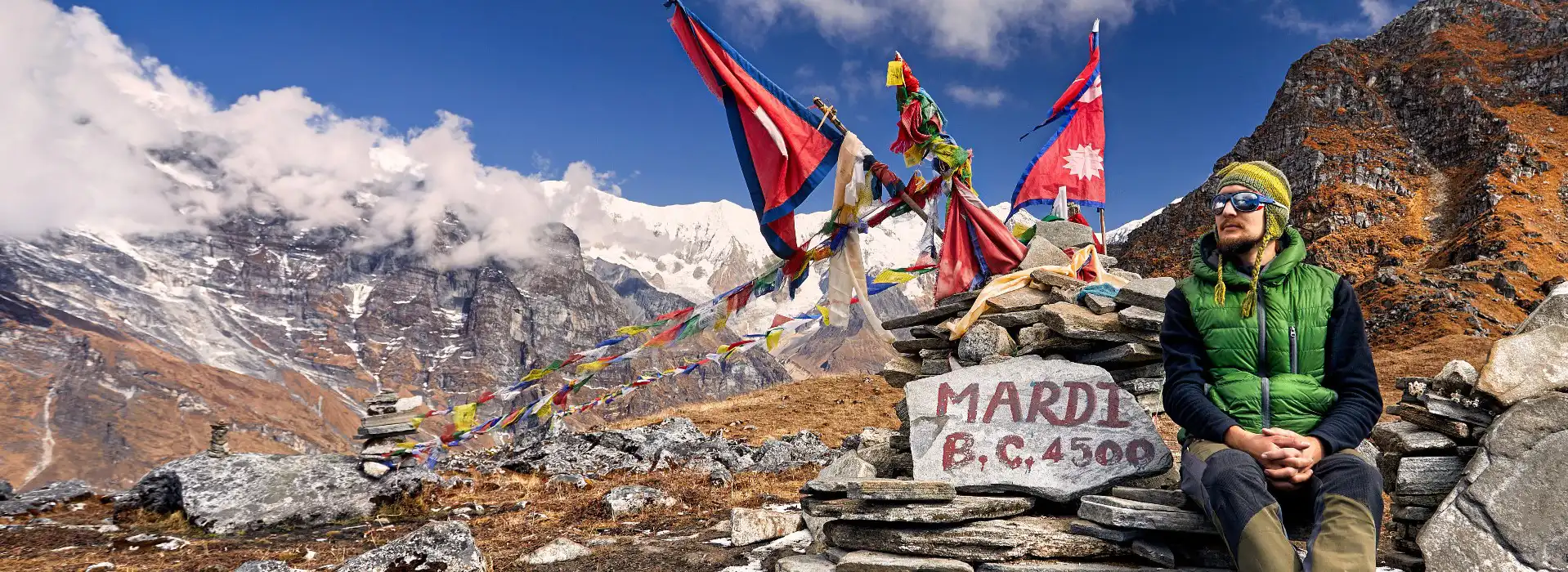
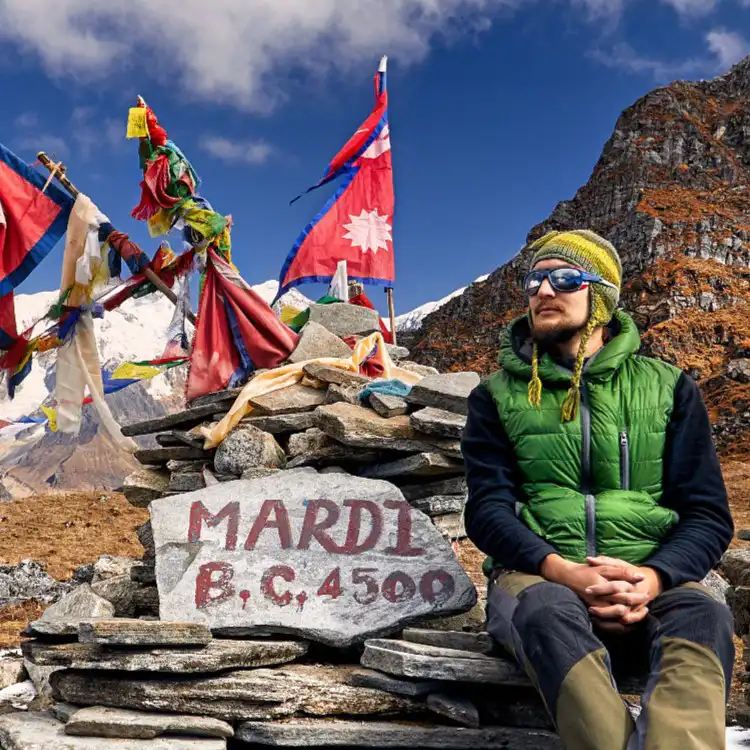
Wandering in pristine nature, closer to the Himalayas, is an opportunity you only get once in a while. Strolling in the remote villages of Nepal and trekking through the colorful forest of Rhododendrons, pine, and oak comprises the best of this mountain country. Among the best trekking places in the world, Nepal is at the top and deserves to be. The Annapurna region of Nepal has been renowned to us for centuries.
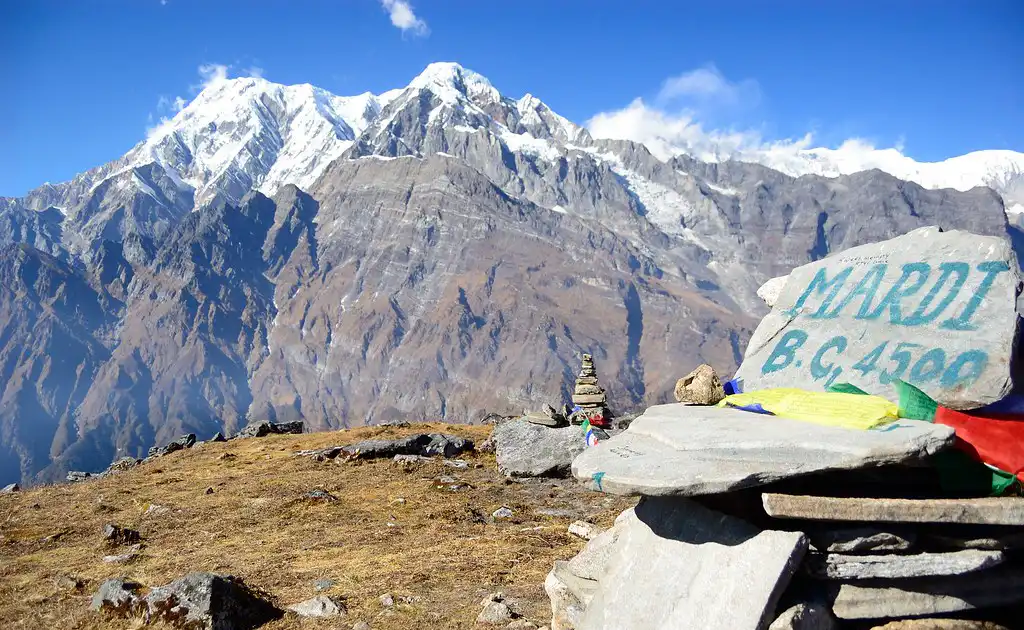
Mardi Himal Trek takes you to the less busiest region of Annapurna in a distinct trail yet unknown to the world. The trail has been closed for trekking since the year 2012. We can say that Mardi Himal is yet an unseen gem. Many trekkers trekked to the base of Mardi Himal, which lies on the side of Annapurna.
The authentic teahouses, quiet trek, easy trail, and terrific views of the Annapurna Range make this tour prodigious. Getting eye in eye with giants like Machhapuchhre, Annapurna South, Mardi Himal, and Hiunchuli makes the most. Especially during spring, the path is packed with different kinds of Rhododendron- Pink, Red, and white.
With the bio-diversity that ranges from tropical farmlands to alpine vegetation, you will witness a huge difference in the flora. Similarly, walking in the Annapurna conversation area, you can spot different wild animals in Nepal. Mardi Himal Trek is not just about the mountains. This trek perfectly blends wild classic Nepalese traditions, wilderness, comfort, and adventure. Doesn’t that sound unique to you?
As you fly into Kathmandu, the capital city of Nepal, the beautiful views over the valley welcome you. On a clear day, the flight offers a view of the Himalayas and terraced fields. After going through customs formalities at the airport, you will see our representative waiting to guide you.
About half an hour’s drive to Kathmandu’s winding streets takes you to the hotel. Once you’ve settled in, take your time to freshen up and recover from the flight. In the evening, you can stroll around to enjoy the lights and music of Thamel.
Later, we will enjoy our welcome dinner and listen to the briefing on the trek from the guide. Afterward, you can hit the club to enjoy Nepal’s nightlife or prepare for the next day’s trip towards Mardi Himal Trek.
Accommodation: The Everest Hotel
Meals: Not Included
Right after breakfast in the morning, we travel overland to Pokhara. En route, we drive along the banks of the Trisuli River and get past many traditional villages and terraced fields. After a few hours of walking, we stop for lunch on the hillside beside the Trisuli River.
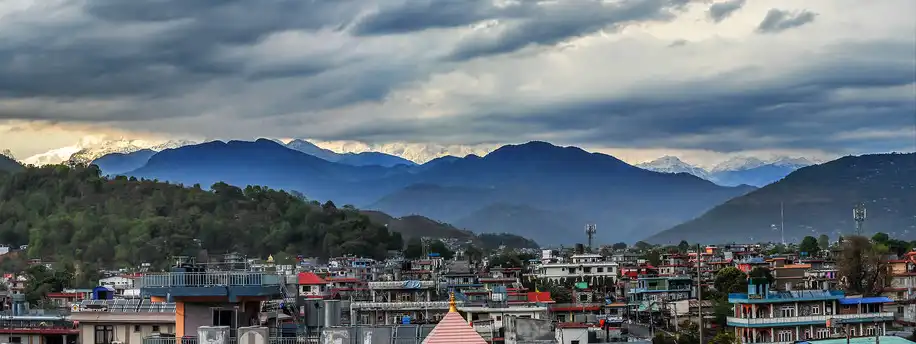
About 7 hours of the luxurious trip bring us to Pokhara. As we enter the city, the clear view of Annapurna ranges welcomes us. After checking into our hotel over at Lakeside, we head out to explore the city. Pokhara, set right on the beautiful Phewa Lake, is an enchanting city. This mesmerizing city is the beginning spot for many popular treks in Nepal.
The thick forests, tranquil blue lakes, and gushing rivers make your trek exciting. After some time rest at your hotel, you can stroll on the bank of the lake. Also, we can enjoy our dinner with live music. The Lakeside is lively during the night.
Accommodation: Kuti Resort or similar
Meal: Breakfast
After breakfast in our hotel, we drive for less than an hour to the starting point of the trek. Dhampus is itself a popular destination among internal tourists. After an unhurried lunch at the Australian Camp, we slowly descend to Pothana.
The trail is straightforward, and we have enough time to enjoy the beauty of this region. After some rest, we climb to Deurali. Here, the forest gets thicker, and the region gets even more beautiful.
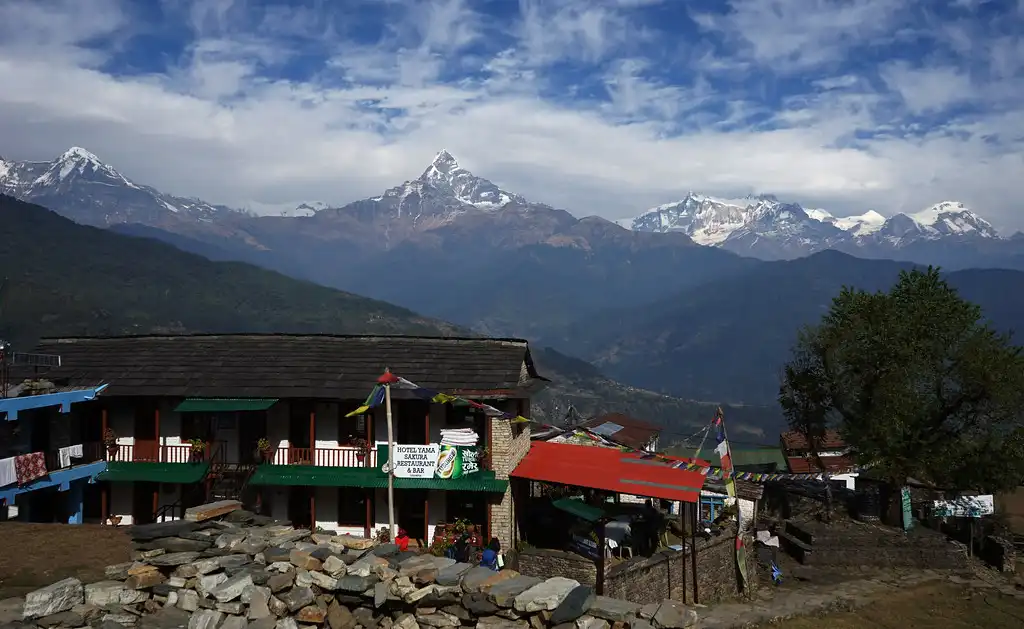
As the sun starts to lower, we stop at Deurali for the night. Deurali has some beautiful lodges and tea houses for your night’s stay. During the daytime, you can see a fantastic view of Machhapuchare from the tea house itself.
Accommodation: Local Lodge
Meals: Breakfast, Lunch, Dinner
This is another easy and relaxing day for the trek. The trail first ascends and then descends to the forest camp. As we leave Durali after breakfast, there is no villages or human settlement until we reach Dund Kharka. This place also has only two hotels with fundamental infrastructure.
From here, the path takes you deeper into the forest. Less than two hours of walk from Dund Khara takes you to Forest Camp. The forest camp lies at the base of the hill between the thick forest. Here, the tea houses have a pretty basic facility with good food.
Accommodation: Local Lodge
Meals: Breakfast, Lunch, Dinner
This can be the longest trek day as we ascend for about 6 hours. After breakfast in the forest camp, we first climb to the rest camp in about 30 minutes. After some rest here, we again stop at a rescue in the middle of the forest.
Then, about an hour of the walk takes us to Low Camp. If you are feeling worn out, we can stop here for lunch. Or, we can climb for another hour to reach the hilltop. As we leave the forest behind, the beautiful mountain landscape greets us.
After other climbing, we get to the middle camp. Then the well-built trail leads us to the high camp of the Mardi Himal Trek. The last part of the trek can be pretty tricky, but you can move slowly and steadily.
The beautiful view of the Himalayas in the Annapurna region already accompanies us. You can see the yaks grazing and their owners guiding them. Today’s trek ends as we crash in a hotel over High camp. Make sure you keep warm and get enough rest for the next day’s trek.
Accommodation: Local Lodge
Meals: Breakfast, Lunch, Dinner
This is the primary day of the Mardi Himal Trek, so we wake up early in the morning, i.e., before 4 am, and do a tough climb to the viewpoint. It’s easier if you have a headlight to climb in the dark. About 2 hours of the walk takes us to the viewpoint where we can see the most stunning sunrise with the Fishtail and Mardi in the back.
On the other side, the majestic Annapurna smiles down at us. After some rest, we head for another two hours of walk to Mardi Himal Base Camp. Here, the majestic Mardi lies right above our heads. For most of the year, the base camp is full of snow.
You can take beautiful pictures and play with the snow before returning to the High camp. The trek back can be exhausting, but the stunning view keeps accompanying us. As we get back to high camp, we enjoy the delicious breakfast and prepare to head back. We can stroll to the Lower camp, our stop for the night.
Accommodation: Local Lodge
Meals: Breakfast, Lunch, Dinner
We will take our time to sightsee the area and enjoy a few last glimpses of the Annapurna before heading back to Jhinu Danda. Today’s trek brings us closer to the upper region of Mardi Khola as we walk on the bank of ice and snow streams. On the easy trail that is mostly downhill, we walk for a couple of hours.
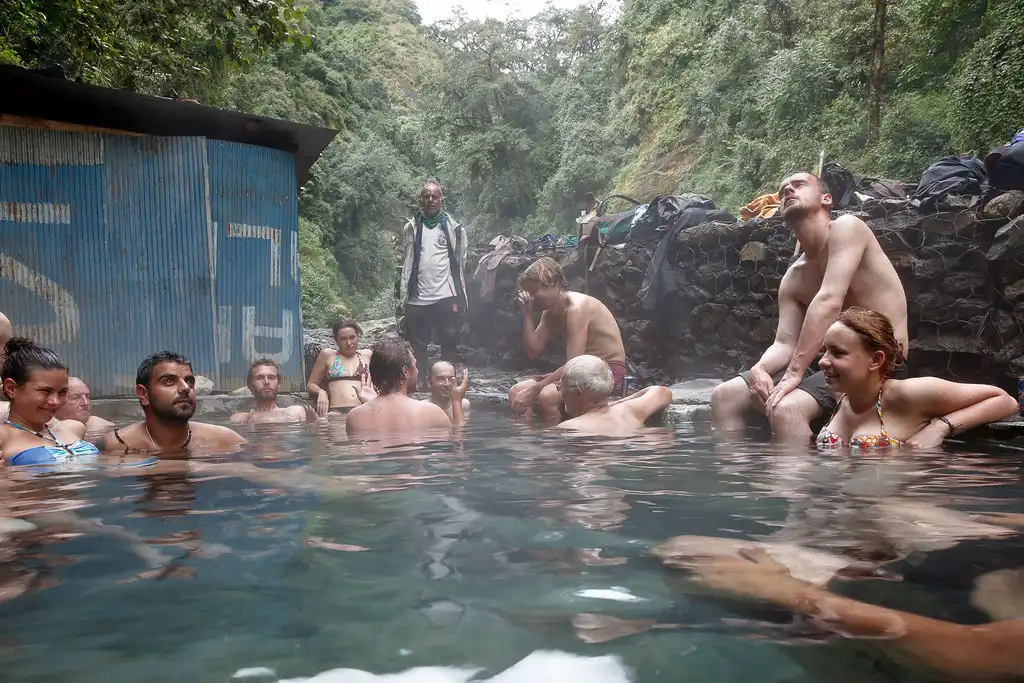
Then, we stop at a natural hot spring in Jhinu danda. A relaxing bath in Jhinu Danda will relieve you from the pain and soreness in your body. Locals believe this hot water spring has the superpower to cure all of your internal and external diseases.
The cultural site of Tamang and Gurung villages will make the tour prodigious. You can capture the beautiful area around the traditional tea houses run by the locals in the region. Take your time interacting with the locals and understanding their lifestyle during the entire Mardi Himal Trek.
Accommodation: Local Lodge
Meals: Breakfast, Lunch, Dinner
It is the last day of our Mardi Himal Trek. First, we leave Jinu danda as we head towards the village of Ghandruk. A short trek takes us to this famous Gurung village, a major tourist destination. Here, we stop to have our lunch. You can also visit the ethnic village or rent a traditional dress for a photo shoot.
You can extend Mardi Himal Trek if you want to stay longer in this magnificent village. After some relaxing hours, we move down to the Ghandruk Phedi- the endpoint of our trek.
Here, we get to Nayapul on a jeep and then drive back to Pokhara in a private car. The short drive will be thrilling as we drive on a rather bumpy path. You can celebrate the successful trek in the evening with a grand dinner in the Lakeside of Pokhara.
Accommodation: Kuti Resort or similar
Meal: Breakfast, Lunch, and Dinner
We end our fantastic trip to the Mardi Himal Trek and drive to Kathmandu. Waving the last goodbye to the Annapurna vista, we get into our bus after breakfast. The drive in the tourist bus on Prithivi Highway will be luxurious. Driving on the bank of Trishuli, we enjoy the greenery in the hills of Nepal.
After a couple of hours of driving, we stop for lunch in a beautiful restaurant overlooking the rivers. In addition, about 7 to 8 hours of drive brings us back to Thamel. You will have some free time to get souvenirs for your loved one or stroll around the hotel. Peregrine Treks Team will host a farewell dinner, and it will be our last dinner together.
Accommodation: The Everest Hotel
Meals: Breakfast, Lunch, and Dinner
Today, you will be flying back to your respective country. Moreover, if your flight is not in the morning, you can have some breakfast and visit new places in Kathmandu. We can add sightseeing and a Scenic Everest mountain flight at your request.
Otherwise, we will drive you to the airport about two hours before your scheduled time. With the last goodbye, you depart for your upcoming trip.
Have a safe flight!!
Meals: Breakfast
Selecting the optimal time for the Mardi Himal Trek is essential for a memorable and pleasurable trek. This trek is becoming increasingly popular due to its spectacular vistas of the Annapurna range, including the majestic Machapuchare, also known as Fishtail Mountain. Understanding the seasonal conditions influencing this trek is crucial for maximizing your adventure.
Autumn stands out as the prime season for the Mardi Himal Trek. Stable weather with clear skies provides stunning mountain views during these months. The moderate temperatures, ranging from 15°C to 20°C in lower regions and cooler in higher altitudes, make trekking conditions ideal.
Excellent visibility allows trekkers to enjoy the panoramic vistas fully, and dry trails decrease the slipping hazard, ensuring safety for trekkers at all skill levels.
Spring marks another excellent time to begin the Mardi Himal Trek. The trails burst into life with vibrant rhododendrons and other wildflowers as winter recedes. Daytime temperatures hover between 16°C and 22°C at lower elevations and more remarkable higher up, making the conditions favorable for reaching the upper camps.
Mornings typically bring clear skies, though afternoons may see some cloud cover. The bustling trails provide great opportunities to connect with other trekkers.
Winter appeals to those who prefer solitary trekking and don’t mind the cold. There are fewer people here, so it’s quieter, but it’s also much colder. Trekkers should use proper winter gear to handle the cold and potential snow on the trails.
Generally, the monsoon season is the least recommended time for the Mardi Himal Trek due to heavy rainfall, which makes the trails slippery and adds the challenge of frequent leeches in the lower forests.
Substantial rain can obscure mountain views and disrupt trekking plans. However, those prepared for these conditions will find the landscapes lush and vibrant, with fewer fellow trekkers.
The Mardi Himal Trek presents a moderate challenge, making it a feasible choice for novices and those with some trekking background. Although not the toughest in the Annapurna region, it demands careful planning and robust physical preparation to ensure a safe and enjoyable trek.
The Mardi Himal Trek features diverse terrain that dramatically shifts as you ascend from the lower elevations to the base camp. Initially, trekkers navigate through dense forests filled with rhododendrons, oak, and pine trees along paths that are generally easy to follow. As the altitude increases, the path steepens, and the terrain becomes rougher, with rocky patches and narrow ridges requiring vigilant footwork.
The trail may occasionally be slippery, particularly after rain or early morning frost. Trekkers should proceed cautiously to prevent accidents, especially when tackling steep sections. The trek doesn’t require technical climbing skills; balance and careful stepping are essential.
One significant challenge of the Mardi Himal Trek is adapting to the altitude. The path leads up to the Mardi Himal Base Camp at roughly 4,500 meters (14,763 feet), where altitude sickness can occur, manifesting as headaches, dizziness, or shortness of breath. Gradual ascent is vital for proper acclimatization to help minimize these risks.
Although the trek promotes gradual elevation increase to aid acclimatization, trekkers need to recognize symptoms of altitude sickness and respond appropriately. Measures include climbing slowly, staying hydrated, and resting as needed. If symptoms worsen, descending is the safest response.
Maintaining a moderate level of physical fitness is essential for undertaking the Mardi Himal Trek. Expect to trek for 5 to 7 hours daily, often on steep inclines, which can be demanding for those unaccustomed to such activity.
Preparing for the trek should involve cardiovascular activities such as running, swimming, cycling, and strength training to enhance stamina. Practicing hikes on uneven surfaces while carrying a backpack is also advised to simulate the trekking experience better. A solid fitness base makes the trek both challenging and achievable.
Weather plays a pivotal role in the difficulty of the Mardi Himal Trek. Spring and autumn typically bring favorable weather with clear skies and moderate temperatures. In contrast, winter introduces cold temperatures and possible snow, complicating navigation. The monsoon season, meanwhile, often brings heavy rains that can make trails slippery and reduce visibility.
To tackle these variable conditions, trekkers should wear the appropriate attire and gear, including waterproof jackets, durable boots, and warm clothing layers for higher elevations. The right equipment is vital to ensure comfort and safety throughout the trek.
As you land in Kathmandu, the capital city of Nepal, we will take you to Pokhara. This so-called city of Lake is itself a heavenly paradise. The tranquil lake, caves and well-developed infrastructure make Pokhara among Nepal’s ” must-visit places.” After exploring Pokhara city, we move further north towards the mountain. A short yet scenic drive in a private car takes you to Dhampus. This is where we begin to walk on foot.
The Mardi Base Camp trek path goes along a small winding trail and passes the enchanted rhododendron forests. Our first stop, i.e., Durali, has some fantastic tea houses decorated with local crafts. We further trek to the Forest Camp in the middle of the thick tropical village. As we climb above 3,300meters, we climb out of the forest into an alpine region. Here, the landscape changes abruptly; the rugged high mountain landscape welcomes us to the upper region. As we reach the high camp, the stunning views of Mardi Himal, Annapurna South, Machapuchre, and Hiunchuli are visible.
We climb to Mardi View Point from High Camp and continue to Mardi Himal Base Camp. Along with Mardi, we see the sunrise with the background of the spectacular Annapurna Range. After enjoying our time in the base camp, it’s time to return to Mardi Low Camp on the same trail. Finally, trekking down to Jhinu dada and Ghandruk Pedi, we drive back to Pokhara.
The trail is full of colorful blooms of wildflowers. What more do you want? The Mardi Himal trek is complete in less than a week without worrying. Comparatively lower altitude, a well-marked trail, and an easy path make the Mardi Himal trek easily achievable to the newbie.
The Mardi Himal Trek is moderately short in the Annapurna region, ranging from 30.5 kilometers to 52 kilometers, depending on the selected route. The most common route starts at Kande and ends at Siding, spanning approximately 49 kilometers over 5 to 7 days.
Trekkers with more time may opt for longer routes that extend to or from Ghandruk or Phedi, adding extra distance and more scenic variations.
The overall distance of the Mardi Himal Trek can vary depending on several factors:
The Mardi Himal Trek spans approximately 49 to 52 kilometers, depending on the chosen route. Typically, trekkers complete the TREK in 5 to 7 days, starting from Kande and ending at Siding.
You can extend the trek by passing through villages like Ghandruk or Landruk, which adds to the distance and enhances the scenic beauty of the trek.
The Mardi Himal Trek is moderately challenging and suitable for beginners and seasoned trekkers. While it involves steep ascents and rugged paths, especially near High Camp and Mardi Himal Base Camp, it’s accessible to those with a reasonable fitness level.
Nepali trekkers generally find the Mardi Himal Trek more affordable than international visitors. Costs include transportation, permits (such as ACAP and TIMS), lodging, and meals. Though expenses vary, budget-friendly options make this trek attractive for locals.
The Mardi Himal Trek is relatively safe, though it carries inherent risks like altitude sickness, sudden weather changes, and challenging terrain.
Proper acclimatization, thorough preparation, and awareness of personal limits can help minimize these risks.
Choosing between the Annapurna Base Camp (ABC) Trek and Mardi Himal Trek depends on what you’re looking for. The ABC Trek is longer and offers iconic views of the Annapurna range, while the Mardi Himal Trek is shorter, less crowded, and serene views of Machapuchare (Fishtail).
The Mardi Himal Trek offers a more solitary experience with higher altitude views. On the other hand, the Poon Hill Trek is shorter and well-known for its stunning sunrise views over the Annapurna and Dhaulagiri ranges.
Your choice depends on whether you prefer a more challenging, remote trek or a shorter, scenic TREK.
Yes, Mardi Himal is generally safe for trekking. The trail is well-marked, and you can minimize risks by following guidelines, such as checking weather forecasts and acclimatizing correctly. Carrying the right gear also enhances safety.
Yes, you can trek Mardi Himal without a guide. The well-marked trail with clear signage makes it suitable for independent trekkers. However, hiring a guide can enrich your experience with local insights and added emergency security.
The Mardi Himal Trek starts from Kande, approximately 27 kilometers by road from Pokhara. After the trek, you can return to Pokhara from Siding, a trip of around 36 kilometers, typically taking about 2 hours by vehicle.

Based on 4 Reviews

The Mardi Himal Trek with Peregrine Treks and Tours was an unforgettable adventure. The views of Machapuchare and the Annapurna range were breathtaking.
The trek was challenging yet rewarding, and the guides were knowledgeable and supportive. I highly recommend this trek for anyone looking for a less crowded trail with stunning scenery!

Excellent






My Mardi Himal Trek experience with Peregrine Treks and Tours was incredible. The trek offered spectacular views, especially from High Camp.
The team at Peregrine was professional and ensured we were well-prepared. The trek is perfect for those seeking a peaceful and scenic route!

Excellent






The Mardi Himal Trek with Peregrine Treks and Tours was an amazing experience. The trail was less crowded, and the views were simply stunning. The team at Peregrine provided excellent service, making sure we were comfortable and safe throughout the trek. I highly recommend this trek for its beauty and tranquility.

Excellent






The Mardi Himal Trek was the perfect escape into nature, and Peregrine Treks and Tours made it all possible. The trek offered stunning views and a peaceful atmosphere. The professionalism and care from the Peregrine team were exceptional. I would recommend this trek to anyone looking to experience the beauty of Nepal.

Excellent





